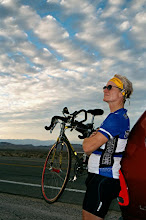A close friend was in charge of volunteers for stage 7 of the 2010 Tour of California, a time trial stage. I volunteered and was assigned to be a chaperone for one of the racers who had to undergo testing for doping. I had no idea what was involved; didn't even know what a "chaperone" did. However, the experience gave me some insight of the inner workings of professional racing, and I thought I'd share the experience here.
We were told to meet at 1:00, at the same time as the time trial was to begin. We met at a back corner of the parking lot where the team vehicles were parked. A spanish fellow explained the protocol to us. There were four of us who would be chaperones for the riders to be tested. Two of those to be tested had been selected at random, with he other two being the stage winner and the GC leader, who would not be known until the completion of the race. I was selected to be a chaperone for one of the randomly selected racers, Francesco Bellotti of Liquigas.
Each of us was given a Amgen staff badge to hang round our neck marked "Anti-Doping Chaperone", a pullover top marked "Chaperone" and a clipboard with a sheet for the details of the person to be tested. For the two of us assigned to the randomly selected racers, our sheets had the name of the rider, and we were required to keep it secret until the person finished the race. Also, we were required to make sure the person started the time trial, because if he didn't, another rider would have to be selected. Once the person started, we were to make our way to the finish, and wait for the person to cross the finish line. Then we were to identify ourselves, and tell the person that he had been identified for anti-doping control. We were to write down the time that we identified ourselves to the person, adding 30 minutes, because each identified racer had 30 minutes to show up at the doping control station, an RV. In addition, the racer had to sign his name to acknowledge the time limit, among other things.
Before Bellottii started, I went by his team warm-up area to watch him to make sure I could later identify him easily. Of course, I did this discreetly, making sure he didn't suspect he was a racer who had been selected for testing. Afterwards I watched him start, then made my way to the finish area. I found a good place to find him at the end and waited for him to arrive. It was a spot where the racers had to stop and go up over a curb before making their way back to the team area. When Bellotti got to the curb, I identified myself and had him sign the form after writing down the time plus 30 minutes.
He was very pleasant, and said he would follow me. Part of the protocol was that I was not to let him out of my sight. He asked to be able to first go to his team RV to change and relax a minute, and I accompanied him inside while he toweled off and got out of some of his cycling clothes. I offered him some water that I had been given for the purpose, and he drank one bottle. When we got to the testing RV, the official in charge spoke with him to find out what language they should use. I believe she was Scandinavian, and her english was very good, but Bellotti's english was not as good, and after a bit of trial and error, they settled on french. After agreeing on the language, he showed his racing license, as is required, and went into the RV to undergo the testing. I was supposed to wait outside until the testing was over. We were told earlier that it was only a urine test, so I was surprised when it took a very long time before he came out, perhaps more than 20 minutes. I didn't ask why the testing took so long. I thanked him, and he was very gracious, not appearing at all inconvenienced by the testing. My responsibilities over, I then returned to the rest of my day.
A final diagnosis
-
A tub of yoghurt followed by two horse pills is my breakfast these days. All
washed down with one or two cups of tea.
Don’t be fooled by the size. Th...
10 years ago


No comments:
Post a Comment